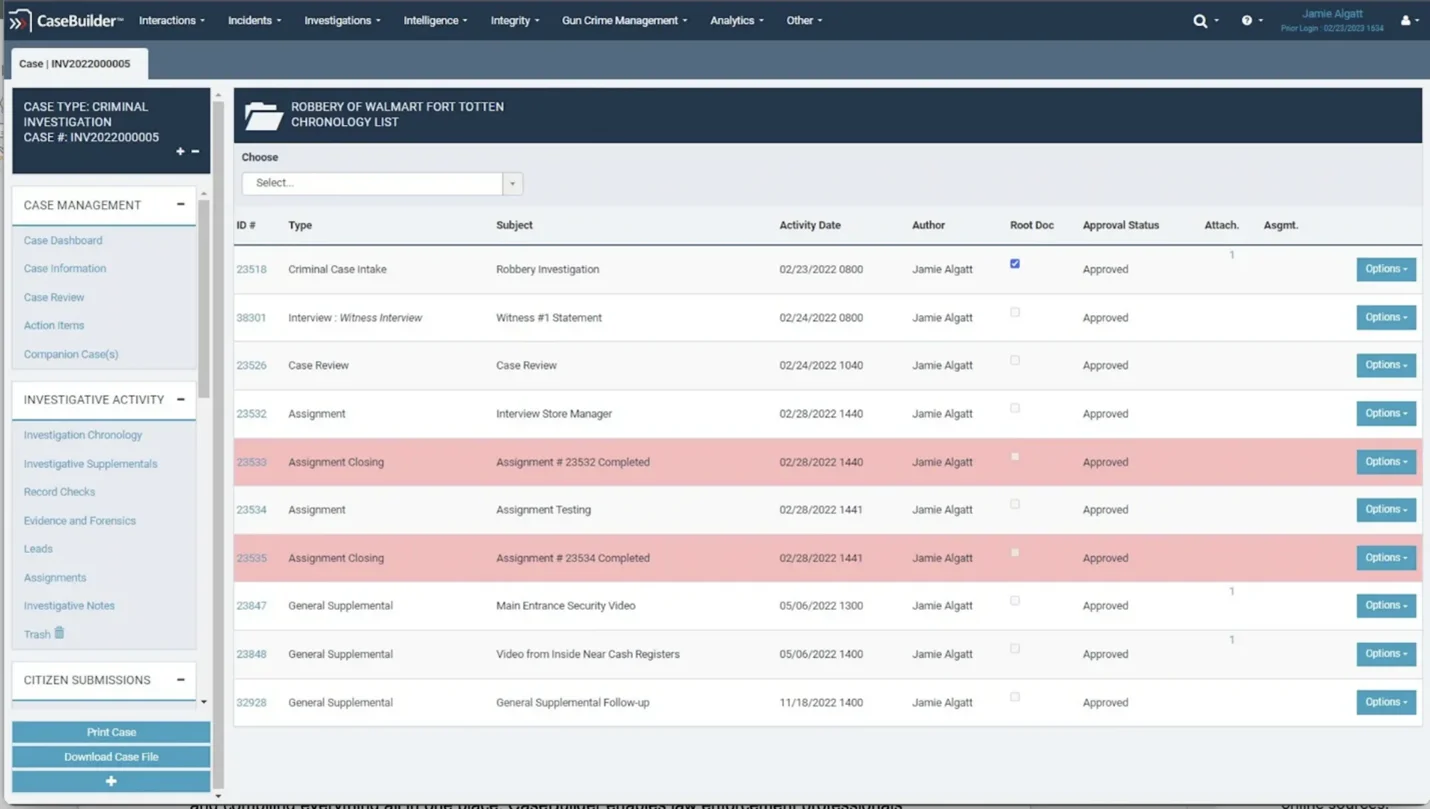Efficiency is the watchword for law enforcement these days. Staffing numbers are down, and while crime rates are falling, they’re still high, especially in persistent trouble spots. Agencies all over the country are dealing with low clearance rates—in 2019, according to the FBI, less than half of all violent crimes and less than 20% of all property crimes in the U.S. were marked cleared. Every agency needs an investigative workflow that strives to improve clearance rates while saving staff time, leading to the question, how do you improve your investigative workflow?
That means agencies and personnel managers must use their resources efficiently, including optimizing their investigative workflows. In 2011, the Office of Justice Programs released its Homicide Best Practices Research Report, which found that implementing investigation management software solutions improves clearance rates. A well-designed solution will also give you a good handle on your investigative workflow.
Managing Investigative Workflow
Effectively and efficiently managing your investigative workflow can be challenging and overwhelming.
- Investigators and managers are often stuck working with outdated tools like spreadsheets (or even pencil and paper) to track assignments and tasks.
- Some agency computer solutions rely upon an inefficient homegrown system or a patchwork combination of software not intended for workflow management.
- Successful investigations require collaboration, but using mismatched systems also inhibits that. For instance, a patrol officer may record a crime in an RMS system and then turn it over to detectives, who use a spreadsheet to document their follow-up activities. At the same time, the evidence from the crime scene is recorded in yet another database.
- Keeping track of a case’s progress and managing staff caseload accordingly is difficult without a single source of truth and a comprehensive overview of its status.
- Improving your investigative workflow in the long term requires assessing the outcome and effectiveness of investigations. That’s difficult to do without access to a central store of information.
Fortunately, there is a way to overcome these difficulties. Investigation management tools have advanced significantly in recent years, and a strong, well-integrated modern solution such as SoundThinking’s CaseBuilder will provide the tools necessary to manage your investigative workflow.
CaseBuilder, a fully automated solution, provides the personnel management, case overview, collaboration, and analytical oversight tools a modern agency needs. In this article, we will show how CaseBuilder can address those pain points, streamline investigative workflow management, and improve clearance rates.
Best Practices For Improving Your Investigative Workflow
We’ve broken down the process of improving your investigative workflow into four steps.
- Replace outmoded methods and tools with a modern, integrated workflow platform.
- Empower collaborators to participate in an investigation.
- Use the platform to track what’s been done and what remains and manage personnel accordingly.
- Assess the effectiveness of workflow and incorporate what you’ve learned.
Let’s take a closer look at these four different areas and how your team can execute each.

CaseBuilder investigative all-in-one infographic
- CaseBuilder allows investigators and supervisors to collect scene descriptions and photos, witness statements and tips, officer reports, links to other crimes, and other details in a single repository. The platform sets up a digital case folder that holds all such information, where multiple investigators can contribute. Having all that material organized and searchable smooths over the bumps inherent in a cobbled-together workflow.
The Denver Marshal’s Office desperately needed case management software, and CaseBuilder answered the call with a system of investigative and analytic reporting tools that make Deputy Marshals more efficient and effective in locating and apprehending fugitives.
- CaseBuilder allows multiple investigators and managers– even those from other agencies with access- to contribute information to the digital case folder and search what’s already there. Contributions can come from outside law enforcement, as detectives can publish wanted posters to the Citizen Portal website.
The ability to specify privacy settings protects the information for the entire folder—ensuring that only authorized stakeholders have access to the files—and for individual items, for instance, to protect confidential sources.
Investigators and managers have their own system inbox and are automatically notified when new information is added to the case folder. CaseBuilder’s integration with SoundThinking’s law enforcement data management solution, CrimeTracer, lets data uncovered from CrimeTracer be automatically added to the CaseBuilder case folder with one click. This integration eliminates a labor-intensive manual entry process that is both time-consuming and error-prone.
Collaboration extends to the prosecution of the case. CaseBuilder’s routing feature packages up the case materials—ensuring to include any supplemental or missing evidence—and passes them to prosecutors with a simple click of the Disseminate Case button.

Courtroom-ready reporting with CaseBuilder
- CaseBuilder provides preconfigured and customizable checklists of investigation action items. This gives managers an invaluable way to guide the agency’s workflow while making sure that investigation actions follow agency standards.
Supervisors can use CaseBuilder to review a case’s status and progress and assign tasks accordingly. The system can automatically notify investigators of any new or overdue assignments via text or email. The platform provides a powerful, easy-to-use way of monitoring and directing your agency’s workflow.

CaseBuilder’s Investigative Dashboard
- The same information that provides the background for internal briefings and assignments is the basis for CaseBuilder’s after-action analysis tools. The Investigate Trend dashboard provides an overview of criminal activity and tendencies over various time periods. That helps supervisory personnel identify resource mismatches and improve the agency’s workflow in the future.

CompStat Trend Dashboard Example from CaseBuilder
The information in CaseBuilder is also useful for providing feedback on the resolution of cases—whether they were successfully prosecuted, sent back for additional information, dismissed, or pending. Communicating the results of the investigator’s work is not only part of managing their workflow but can also help enhance teamwork and positively influence morale.
CaseBuilder Streamlines Investigations
CaseBuilder offers a robust collection of investigation management features, from providing a place to collect and organize evidence before passing the case off for prosecution. It has the capabilities necessary for law enforcement managers to keep an agency’s workflow on track and improve investigative workflows in the future.
CaseBuilder is the key tool for achieving the effective processes necessary in today’s law enforcement. If you want to improve your investigative workflow, contact us to talk more about how CaseBuilder from SoundThinking can improve efficiency in your agency. CaseBuilder case management provides ways to address the obstacles to improving your agency’s workflow. Improved flow and processes lead to more effective policing, use of resources, and, most importantly, improved clearance rates.




